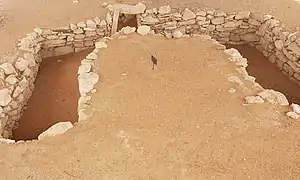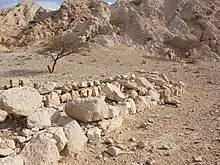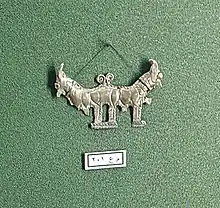Wadi Suq culture
The Wadi Suq culture defines human settlement in the United Arab Emirates and Oman in the period from 2,000 to 1,300 BCE. It takes its name from a wadi, or waterway, west of Sohar in Oman and follows on from the Umm al-Nar culture. Although archaeologists have traditionally tended to view the differences in human settlements and burials between the Umm Al Nar and Wadi Suq periods as the result of major external disruption (climate change, the collapse of trade or threat of war), contemporary opinion has moved towards a gradual change in human society which is centred around more sophisticated approaches to animal husbandry[1] as well as changes in the surrounding trade and social environments.

Part of a series on the |
|---|
| History of the United Arab Emirates |
 |
|
|
History

The transition between Umm Al Nar and Wadi Suq is thought to have taken some 200 years and more, with finds at the important Wadi Suq site of Tell Abraq in modern Umm Al Qawain showing evidence of the continuity of Umm al-Nar burials.[1] Evidence of increased mobility among the population points to a gradual change in human habits rather than sudden change[2] and important Wadi Suq era sites such as Tell Abraq, Ed Dur, Seih Al Harf, Shimal and Kalba show an increasing sophistication in copper and bronze ware as well as trade links both east to the Indus Valley and west to Mesopotamia.[3] Wadi Suq era pottery is also seen as more refined and distinctive, with finds of painted ware common,[4] and the development of soft-stone vessels.
Studies of human remains from the period do point to a process of aridification taking place over the centuries contiguous between the Umm Al Nar and Wadi Suq periods, but do not support a sudden or cataclysmic movement or societal change rather a gradual shift in culture.[5]
The Wadi Suq people not only domesticated camels, but there is evidence they also planted crops of wheat, barley and dates.[3] A gradual shift away from coastal to inland settlements took place through the period.[6]
Burials
Some of the most obvious evidence of the change in human habits and society following the Umm Al Nar period can be found in the distinctive burials of the Wadi Suq people, notably in Shimal in Ras Al Khaimah where over 250 burial sites are located. In some cases, cut stone from Umm Al Nar burials has been used to build Wadi Suq graves. Wadi Suq burials are long chambers entered from the side and many have been found to have been used for subsequent burials. Although Shimal has the most extensive Wadi Suq burials, grave sites are to be found throughout the UAE and Oman and vary from simple barrows to sophisticated structures.[7]
The notable Jebel Buhais burial ground, the oldest radiometrically dated burial site in the UAE,[8] is an extensive necropolis, consisting of burial sites spanning the Stone, Iron, Bronze and Hellenistic ages of human settlement in the UAE. The widespread area of burials exhibits a number of important Wadi Suq tombs, including a unique clover-leaf shaped burial chamber, but has no evidence of Umm Al Nar era burials, although there are burials representing later eras, including the Hellenistic. The clover-shaped Wadi Suq period tomb at Jebel Buhais, BHS 66 stands as a unique piece of funerary architecture in the UAE.[9]
Artefacts

Wadi Suq era weaponry shows a marked increase in sophistication, with an explosion in metallurgy taking place in the region. A number of tombs have been found with hundreds of weapons and other metal artefacts and long swords, bows and arrows became the predominant weapons. Long swords found at Qattara, Qidfa, Qusais and Bidaa bint Saud are double-edged and hilted. Light throwing spears also marked the weaponry of the time. Many of these weapons were cast in bronze.[10] One grave excavated in Shimal had no fewer than 18 fine bronze arrowheads.
Another explosive growth industry in the Wadi Suq era was the production of soft-stone vessels. While in the preceding Umm al-Nar era these were distinctively decorated with dotted circles, they now gained incised patterns of lines and are found in some profusion.[10]
The relative wealth and growing metallurgical sophistication of the Wadi Suq people is displayed by finds of jewellery, including gold and electrum plaques depicting back to back animals. Ongoing links with both Dilmun and the Indus Valley have been demonstrated.[11]
References
- "Societal changes in Bronze Age Arabia... here's the tooth in the matter". The National. Retrieved 2017-12-05.
- Carter, R. (1997). "The Wadi Suq period in south-east Arabia: a reappraisal in the light of excavations at Kalba, UAE". Proceedings of the Seminar for Arabian Studies. 27: 87–98. JSTOR 41223590.
- 1968-, Magee, Peter (2014-05-19). The archaeology of prehistoric Arabia : adaptation and social formation from the neolithic to the iron age. New York. ISBN 9780521862318. OCLC 852824778.CS1 maint: numeric names: authors list (link)
- Potts, Daniel T.; Nābūdah, Ḥasan Muḥammad; Hellyer, Peter (2003). Archaeology of the United Arab Emirates. London: Trident Press. pp. 174–177. ISBN 978-1-9007-2488-3. OCLC 54405078.
- Gregoricka, L. A. (2016-03-01). "Human Response to Climate Change during the Umm an-Nar/Wadi Suq Transition in the United Arab Emirates". International Journal of Osteoarchaeology. 26 (2): 211–220. doi:10.1002/oa.2409. ISSN 1099-1212.
- 1963-, Hawker, Ronald William (2008). Traditional architecture of the Arabian Gulf : building on desert tides. Southampton, UK: WIT. ISBN 9781845641351. OCLC 191244229.CS1 maint: numeric names: authors list (link)
- Heritage, Sharjah Directorate of Antiquities &. "Jebel Al Buhais – Sharjah Directorate of Antiquities & Heritage". sharjaharchaeology.com. Retrieved 2017-12-05.
- Kiesewetter, Henrike (1999). "Neolithic jewellery from Jebel al-Buhais 18". Proceedings of the Seminar for Arabian Studies. 30: 137–146. JSTOR 41223703.
- "Jebel al-Buhais. Art Destination Sharjah". universes.art. Retrieved 2018-04-18.
- United Arab Emirates : a new perspective. Abed, Ibrahim., Hellyer, Peter. London: Trident Press. 2001. p. 46. ISBN 978-1900724470. OCLC 47140175.CS1 maint: others (link)
- United Arab Emirates : a new perspective. Abed, Ibrahim., Hellyer, Peter. London: Trident Press. 2001. p. 48. ISBN 978-1900724470. OCLC 47140175.CS1 maint: others (link)